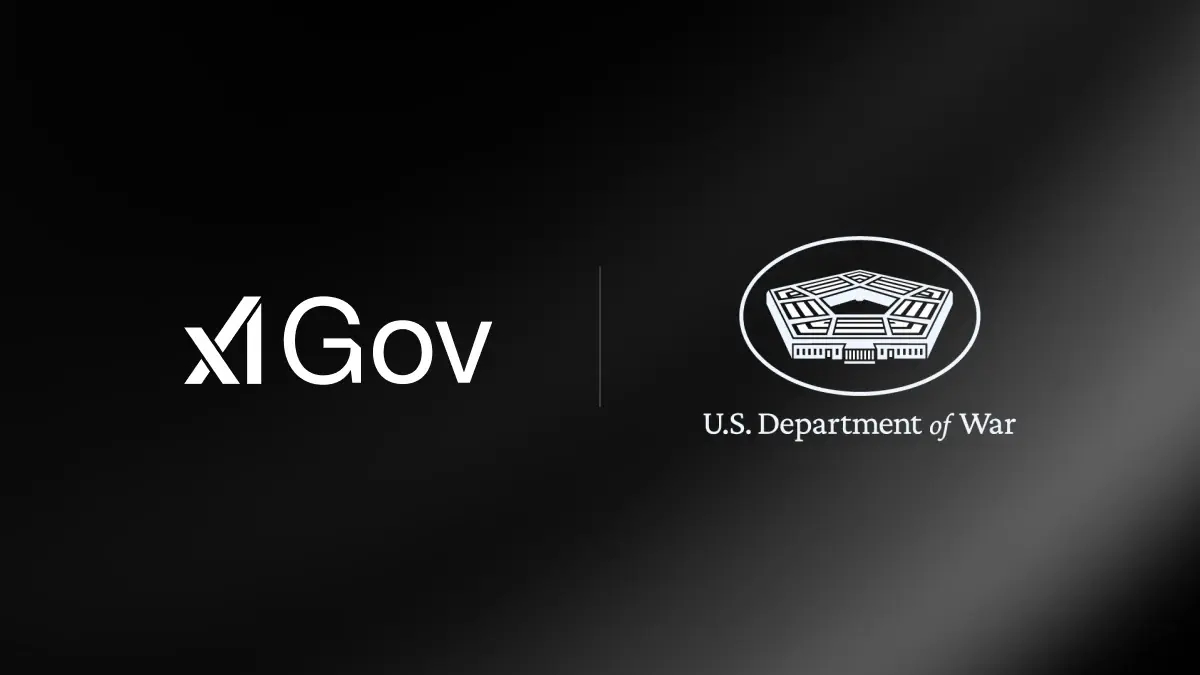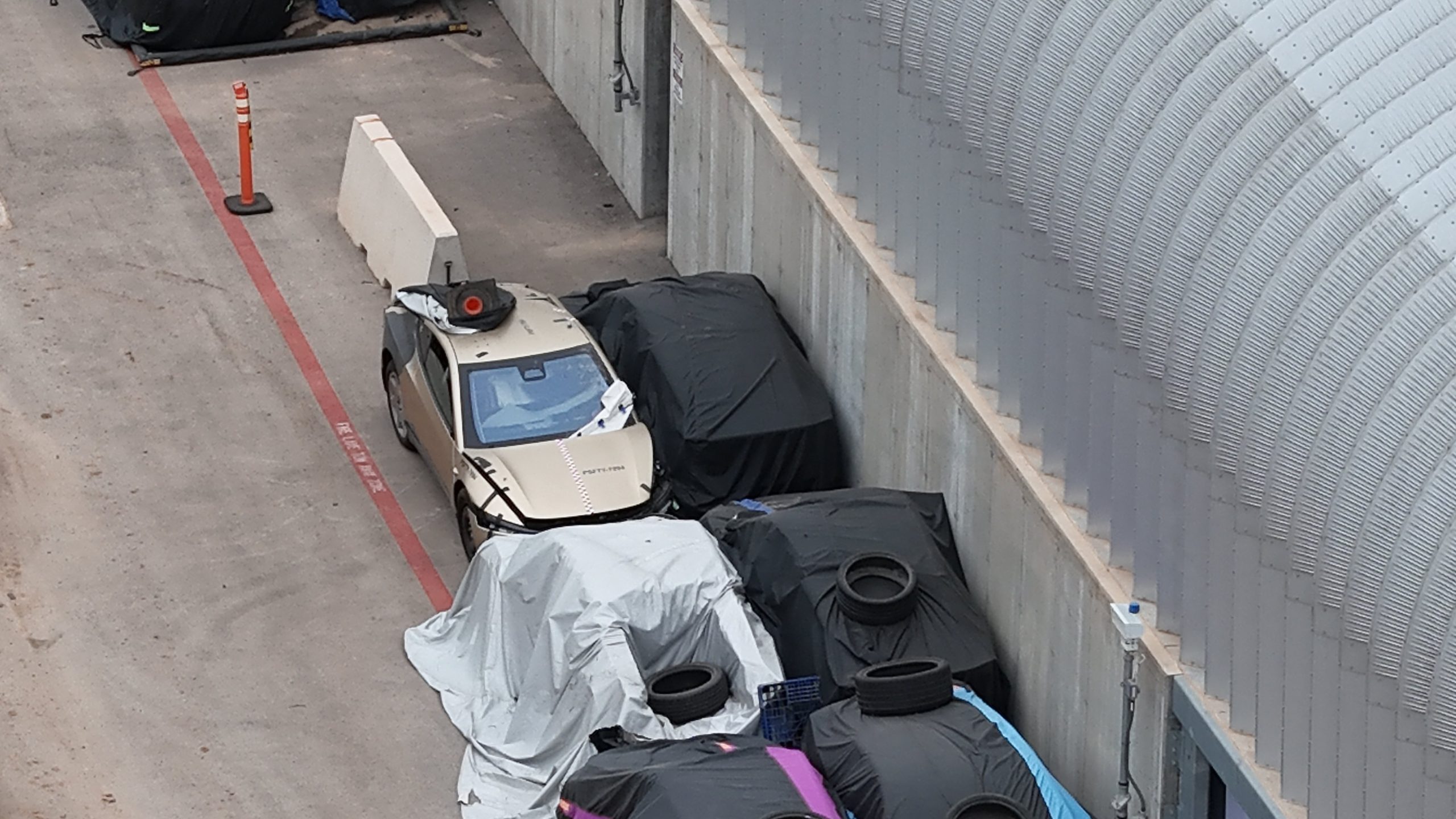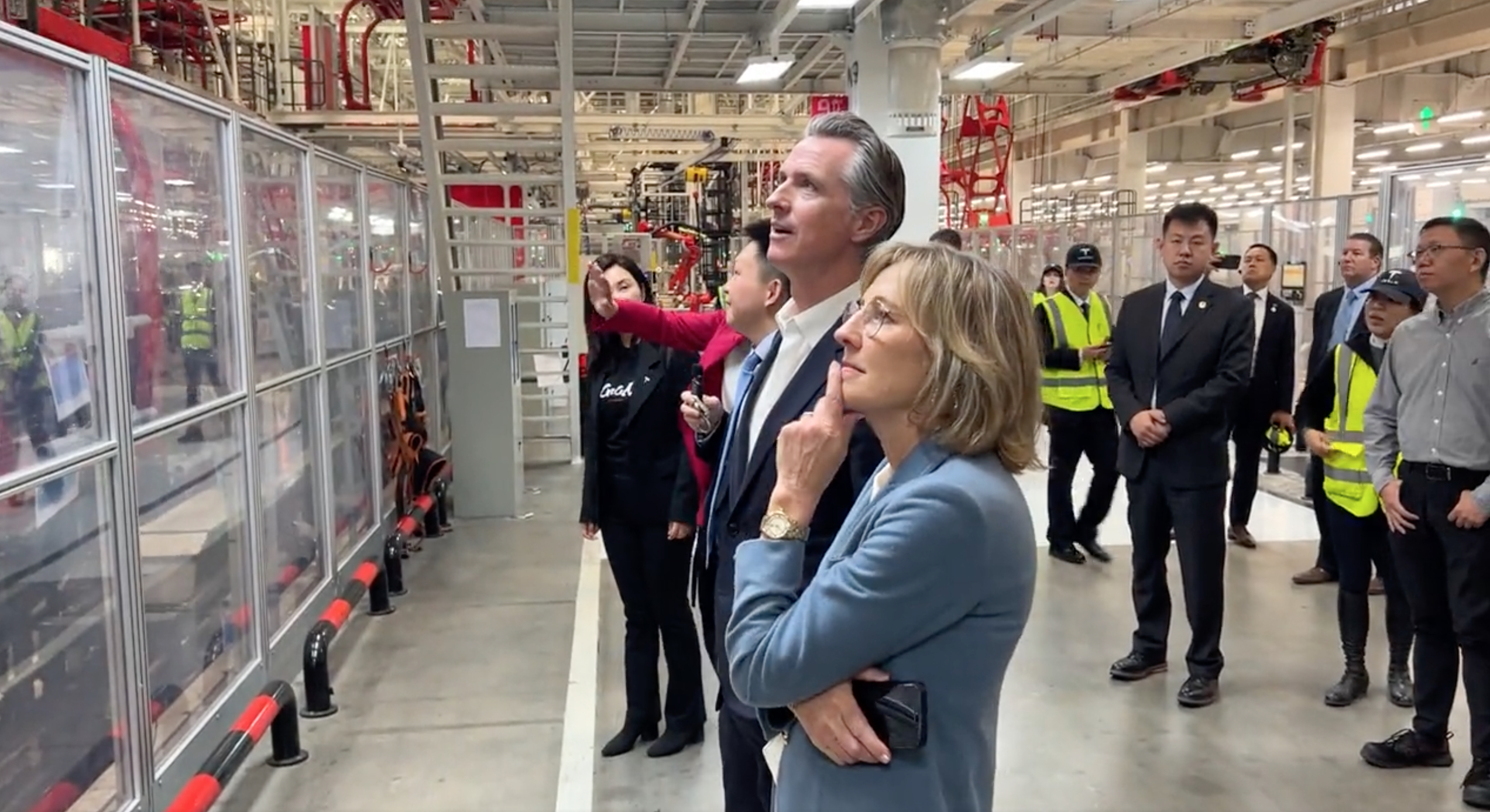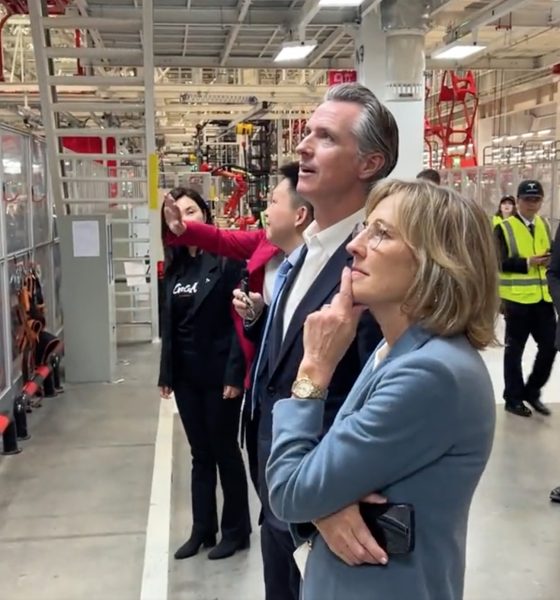California Governor Gavin Newsom is currently visiting China to discuss climate initiatives, and one stop on Sunday included a visit to U.S. automaker Tesla’s factory in Shanghai.
Governor Newsom visited and toured the Tesla Gigafactory in Shanghai on Sunday, as detailed ahead of the trip by Cal Matters and reported by Elex Michaelson in a video on X. The visit to the world’s most productive electric vehicle (EV) plant underscores the unique relationship between the U.S. and China, as the latter country still controls much of the supply chain for EV battery materials.
The visit is intended to look at how China and California can cooperate on climate goals, and it included trips to Shenzen, where a fully electric 16,000-bus fleet is operational, an offshore wind facility in Jiangsu, and finally, the Shanghai facility. In addition, Newsom test-drove one of BYD’s hybrid vehicles and held a meeting in Beijing with Chinese President Xi Jinping.
In the video shared by Michaelson, you can see Newsom and other officials watching as the Model Y production line is in action. Michaelson notes that the facility produces around 2,000 cars per day at Giga Shanghai.
.@GavinNewsom tours @Tesla’s gigafactory outside Shanghai, China.
They produce 2,000 new cars a day here. pic.twitter.com/DE62OyEWKL
— Elex Michaelson (@Elex_Michaelson) October 29, 2023
In a separate video shared on X by WuWa on Sunday, Newsom was asked multiple questions outside of Giga Shanghai, including how he saw Tesla’s role in the cooperation between the U.S. and China.
“It’s demonstrable,” Newsom said. “I mean the jobs it’s created, the entrepreneurial spirit, the innovation. I’m happy to see the success of this facility.”
Newsom was also asked if he would talk to Tesla CEO Elon Musk when he returns to the U.S. about what he saw at Giga Shanghai, responding that he “imagines” they will, and noting that Tesla moved its engineering and R&D headquarters back to California earlier this year, as located in Palo Alto. Tesla also operates a large factory in Fremont, California.
Additionally, Newsom was spotted test-driving Tesla’s newly redesigned Model 3, which you can see below in a video shared by Sawyer Merritt.
California governor Gavin Newsom test drives the new Tesla Model 3pic.twitter.com/khN7Y7UTC6
— Sawyer Merritt (@SawyerMerritt) October 29, 2023
During his time in Jiangsu, Governor Newsom also signed a memorandum of understanding on climate change work, with a particular focus on offshore wind development. The state of California hopes to be producing 25 gigawatts of offshore wind electricity by 2045, which could provide around 13 percent of the state’s power supply and could power roughly 25 million homes in the state.
California has particularly ambitious climate and EV adoption goals compared to many other U.S. states, including a ban on the sale of new gas cars starting in 2035. Although the state has been ahead of the U.S. on EV adoption thus far, China still remains the top miner and producer of EV battery materials.
According to U.K. firm TechInsights, China manages about 80 percent of the world’s cobalt processing, 76 percent of the world’s natural graphite processing, 56 percent of its synthetic graphite and 60 percent of the world’s processing capacity for lithium compounds. The country also produces 50 percent of the world’s sodium hydroxide.
President Joe Biden’s Inflation Reduction Act (IRA) requires at least half of all EV battery components to be sourced in the U.S. or from a country with a free trade agreement.
California to disperse $40.5 million in funding for EV fast-chargers
What are your thoughts? Let me know at zach@teslarati.com, find me on X at @zacharyvisconti, or send your tips to us at tips@teslarati.com.

News
Elon Musk’s Grok AI to be used in U.S. War Department’s bespoke AI platform
The partnership aims to provide advanced capabilities to 3 million military and civilian personnel.

The U.S. Department of War announced Monday an agreement with Elon Musk’s xAI to embed the company’s frontier artificial intelligence systems, powered by the Grok family of models, into the department’s bespoke AI platform GenAI.mil.
The partnership aims to provide advanced capabilities to 3 million military and civilian personnel, with initial deployment targeted for early 2026 at Impact Level 5 (IL5) for secure handling of Controlled Unclassified Information.
xAI Integration
As noted by the War Department’s press release, GenAI.mil, its bespoke AI platform, will gain xAI for the Government’s suite of tools, which enable real-time global insights from the X platform for “decisive information advantage.” The rollout builds on xAI’s July launch of products for U.S. government customers, including federal, state, local, and national security use cases.
“Targeted for initial deployment in early 2026, this integration will allow all military and civilian personnel to use xAI’s capabilities at Impact Level 5 (IL5), enabling the secure handling of Controlled Unclassified Information (CUI) in daily workflows. Users will also gain access to real‑time global insights from the X platform, providing War Department personnel with a decisive information advantage,” the Department of War wrote in a press release.
Strategic advantages
The deal marks another step in the Department of War’s efforts to use cutting-edge AI in its operations. xAI, for its part, highlighted that its tools can support administrative tasks at the federal, state and local levels, as well as “critical mission use cases” at the front line of military operations.
“The War Department will continue scaling an AI ecosystem built for speed, security, and decision superiority. Newly IL5-certified capabilities will empower every aspect of the Department’s workforce, turning AI into a daily operational asset. This announcement marks another milestone in America’s AI revolution, and the War Department is driving that momentum forward,” the War Department noted.
News
Tesla FSD (Supervised) v14.2.2 starts rolling out
The update focuses on smoother real-world performance, better obstacle awareness, and precise end-of-trip routing, among other improvements.

Tesla has started rolling out Full Self-Driving (Supervised) v14.2.2, bringing further refinements to its most advanced driver-assist system. The new FSD update focuses on smoother real-world performance, better obstacle awareness, and precise end-of-trip routing, among other improvements.
Key FSD v14.2.2 improvements
As noted by Not a Tesla App, FSD v14.2.2 upgrades the vision encoder neural network with higher resolution features, enhancing detection of emergency vehicles, road obstacles, and human gestures. New Arrival Options let users select preferred drop-off styles, such as Parking Lot, Street, Driveway, Parking Garage, or Curbside, with the navigation pin automatically adjusting to the user’s ideal spot for precision.
Other additions include pulling over for emergency vehicles, real-time vision-based detours for blocked roads, improved gate and debris handling, and extreme Speed Profiles for customized driving styles. Reliability gains cover fault recovery, residue alerts on the windshield, and automatic narrow-field camera washing for new 2026 Model Y units.
FSD v14.2.2 also boosts unprotected turns, lane changes, cut-ins, and school bus scenarios, among other things. Tesla also noted that users’ FSD statistics will be saved under Controls > Autopilot, which should help drivers easily view how much they are using FSD in their daily drives.
Key FSD v14.2.2 release notes
Full Self-Driving (Supervised) v14.2.2 includes:
- Upgraded the neural network vision encoder, leveraging higher resolution features to further improve scenarios like handling emergency vehicles, obstacles on the road, and human gestures.
- Added Arrival Options for you to select where FSD should park: in a Parking Lot, on the Street, in a Driveway, in a Parking Garage, or at the Curbside.
- Added handling to pull over or yield for emergency vehicles (e.g. police cars, fire trucks, ambulances).
- Added navigation and routing into the vision-based neural network for real-time handling of blocked roads and detours.
- Added additional Speed Profile to further customize driving style preference.
- Improved handling for static and dynamic gates.
- Improved offsetting for road debris (e.g. tires, tree branches, boxes).
- Improve handling of several scenarios, including unprotected turns, lane changes, vehicle cut-ins, and school buses.
- Improved FSD’s ability to manage system faults and recover smoothly from degraded operation for enhanced reliability.
- Added alerting for residue build-up on interior windshield that may impact front camera visibility. If affected, visit Service for cleaning!
- Added automatic narrow field washing to provide rapid and efficient front camera self-cleaning, and optimize aerodynamics wash at higher vehicle speed.
- Camera visibility can lead to increased attention monitoring sensitivity.
Upcoming Improvements:
- Overall smoothness and sentience.
- Parking spot selection and parking quality.
News
Tesla is not sparing any expense in ensuring the Cybercab is safe
Images shared by the longtime watcher showed 16 Cybercab prototypes parked near Giga Texas’ dedicated crash test facility.

The Tesla Cybercab could very well be the safest taxi on the road when it is released and deployed for public use. This was, at least, hinted at by the intensive safety tests that Tesla seems to be putting the autonomous two-seater through at its Giga Texas crash test facility.
Intensive crash tests
As per recent images from longtime Giga Texas watcher and drone operator Joe Tegtmeyer, Tesla seems to be very busy crash testing Cybercab units. Images shared by the longtime watcher showed 16 Cybercab prototypes parked near Giga Texas’ dedicated crash test facility just before the holidays.
Tegtmeyer’s aerial photos showed the prototypes clustered outside the factory’s testing building. Some uncovered Cybercabs showed notable damage and one even had its airbags engaged. With Cybercab production expected to start in about 130 days, it appears that Tesla is very busy ensuring that its autonomous two-seater ends up becoming the safest taxi on public roads.
Prioritizing safety
With no human driver controls, the Cybercab demands exceptional active and passive safety systems to protect occupants in any scenario. Considering Tesla’s reputation, it is then understandable that the company seems to be sparing no expense in ensuring that the Cybercab is as safe as possible.
Tesla’s focus on safety was recently highlighted when the Cybertruck achieved a Top Safety Pick+ rating from the Insurance Institute for Highway Safety (IIHS). This was a notable victory for the Cybertruck as critics have long claimed that the vehicle will be one of, if not the, most unsafe truck on the road due to its appearance. The vehicle’s Top Safety Pick+ rating, if any, simply proved that Tesla never neglects to make its cars as safe as possible, and that definitely includes the Cybercab.










